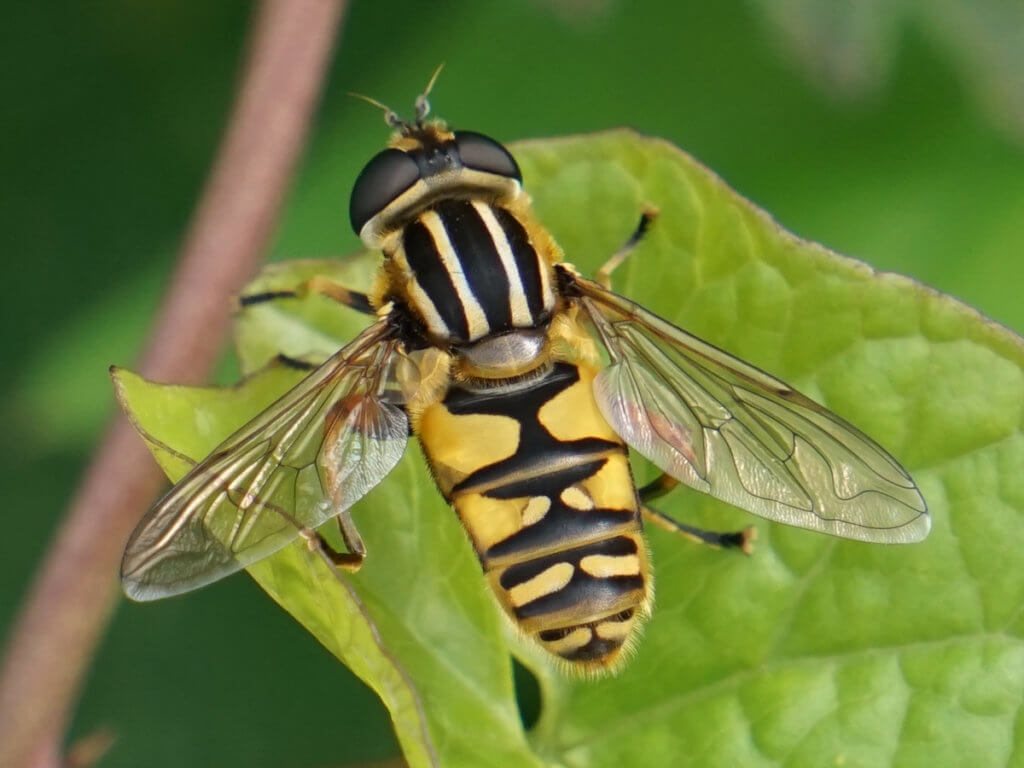
Paul writes: This is a beautiful brightly coloured hoverfly. It is sometimes known as The Footballer, probably from the days when lots of teams wore striped shirts! It’s one of the commonest and most widespread hoverflies and is seen throughout the UK. It has a long flight period. I usually see them from the middle of April right through to the end of October. This one was found on 1 September last year, on a bit of rough ground outside my house in North Yorkshire. You will often find it on garden or hedgerow flowers or even just resting on leaves, like this one is.
[registration_form]
I have subjectively noticed a dramatic decline in hoverfly populations, even over the last five years or so (in Oxfordshire, considered to be a rural county – but following Maastricht and its uncontrolled immigration – now fast being turned into a dormitory county for London). I do look out for them.
However, even such a dramatic decline is nothing compared to the loss since I grew up in the sixties. I would subjectively estimate the loss since then as being as much as 99%.
I can drive across the county during mid-summer daylight and hardy notice windscreen insect impacts. That would have been impossible in the sixties without having to use windscreen wipers several times.
I can testify to the same effect on bird strikes (excluding introduced pheasant, of course, where the opposite has happened).
Something very serious is happening.
Your subjective impressions of decline and loss are corroborated by a lot of hard data Keith, sad to say.
I’d never heard it called ‘the footballer’ before – but that’s what I shall call it from now! My Collins guide calls it ‘the sun-fly’.
I agree with Keith Dancey about the dramatic decline of wildlife.The loss is not limited to birds and mammals.
I live in a very rural part of Derbyshire where the landscape has changed very little, but many species of wildlife, which were common in the sixties ,and seventies have gone.Butterflies were very common in my garden, too many to count, small tortoiseshells red admirals, up to sixteen species.This year below seventy, and these include the hardy cabbage whites.
In another few days the frogs ,toads and newts will be on the move, they will be slaughtered by traffic on the lanes.Each year there fewer and fewer killed, which must say something.Lizards none for some years.Hares a distant memory, although badgers get the blames for their demise.
My latest observation is the decline of rabbits, once very common in this area but now scarce, even rabbits, where will it stop.?
The larvae are aquatic and the adults can often be found on the vegetation around the edges of ponds and other water bodies. A very bonny hoverfly.
Keith’s suggestion that the decline of this hoverfly is connected with immigration is fanciful at best.
Eddie’s comment is far closer to the mark – yes, superficially the countryside may not appear to have changed much – partly because it is slow and we don’t keep track of it, but moreso that behind that meadow or field of barley the in-field farming has changed steadily and disastrously until there is as little left for wildlife as possible.
Oh dear, Roderick! First, I said that a rural county is being turned into a dormitory for London because of immigration (population increase of 38% in the next 13 years; one million new homes in the corridor between Oxford and Cambridge by 2050. Neither of those disastrous policies are remotely possible without mass immigration.)
Second, you agree that farming has changed steadily and disastrously until there is as little left for wildlife as possible, yet you claim that it is ‘fanciful’ to suggest that this has anything to do with our rocketing human population, or that our rocketing population increase is anything to do with uncontrolled immigration.
So, how do you square the circle, please?
Dear Keith,
If by ‘immigration’ you mean rich people from London moving to Oxfordshire to send their kids to private schools there I’d have to agree with you. If you mean people coming from other countries I fear only prejudice will support your case – look rather at the flight to the south and demographics – more, smaller households.
I fear also that a direct link between farming practise and population is stretching it a bit, too – the myth of food security. Framers are intensifying in the face of ever declining prices – because they and the Government have persuaded us that cheap food is good (up until it floods your house) and because the worldwide agricultural market simply isn’t working – the vast power of a small number of big retailers vs the near powerless thousands of farmers + , if you’re not lucky enough to be in the first world, the huge subsidies of Europe & the US – and by the way, the Americans will soon be trying to force their massively subsidised food on us under the banner of free trade. If we were so self contained why do the farmers and Defra seem so obsessed with exporting food ?